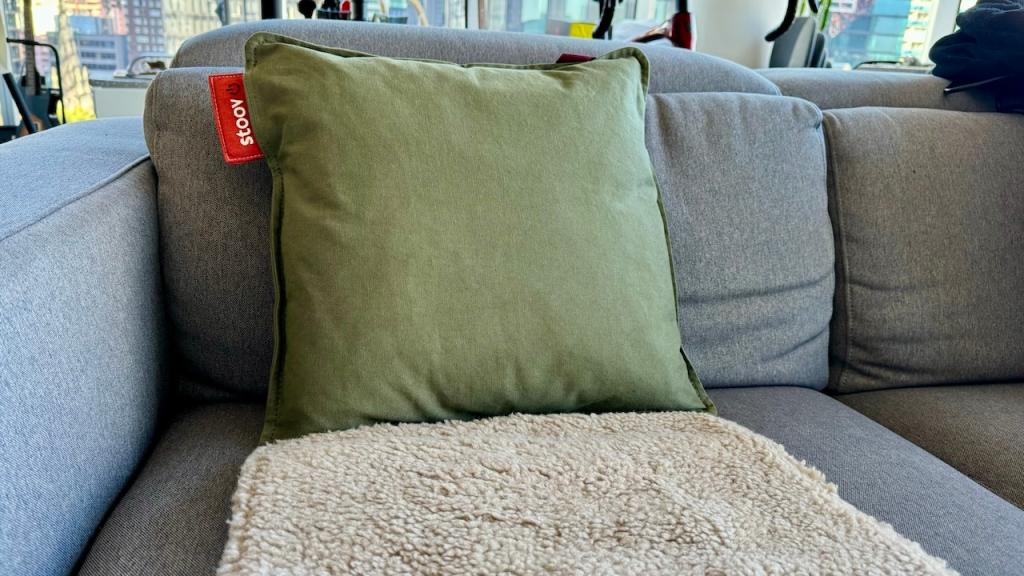Many things can be true at once. For example: Not everything needs a battery, expensive gimmick products are stupid, and, perhaps most importantly, this $174 rechargeable throw pillow is the greatest thing and you need one this winter. Do you have a bad back? You need a Stoov. Do you have a uterus? You need a Stoov. Is it winter/are you in Tasmania? You need a Stoov.
To be more specific, Stoov is a company that makes a range of heated throw pillows, cushions, waterless “hot water bottles” and heating pads. I’ve spent the last few weeks with the $174 square Ploov, $169 Homey heating “bottle” and the $224 Big Hug heating pad, and now my wife and I can’t imagine life without them.
What I Love about Stoov
They’re wireless
I’ve seen a lot of heated throw rugs and electric heating pads, but they all require you to be plugged into the wall because generating heat uses a bunch of power. These are heating cushions you could taking camping, or use in a pillow fort without having to worry about needing a socket between charges. I just think it’s neat.
You can use it while charging
Charging takes 2-4 hours (depending on which Stoov you get), and they can stay at their top temperature for 1.5-2.5 hours, so that ratio can be frustrating. I really appreciate that you can use the Stoov while charging, because then I can just leave it on the whole night while I watch TV. What’s also nice is that when it turns off on the automatic timer, it doesn’t just go from all to nothing, but it takes a gradual step down the settings.
It’s easy to replace the different parts if anything goes wrong
I like the first thing you do is plug the various parts in and see where and how they go. I’m now so used to products being one connected ball of things that you can’t replace any part on that it’s really refreshing to see something where you can replace the rechargeable battery easily, or the body or cover of the cushion. It’s something that used to be standard, and should still be the standard, but it isn’t, so I’m glad it’s included on the Stoov.
What I Don’t Love about Stoov

The size of the Homey isn’t ideal for back pain
It’s just not quite long enough to be used in the small of your back on a couch without the battery digging in. It’s absolutely wild how much it feels like a hot water bottle, despite not containing water, which is nice, but the shape limits the positions it can be most useful in. For this reason, I plan on buying one of the rectangular Ploovs soon, and I think I would recommend that other people with lower back pain do the same thing.
The whole range could also be a bit softer, but that’s a personal preference thing.
It’s not easy to see battery status
It would be nice to get some warning before it just ran out of battery and left me cold. Like, a little vibration or something, rather than just gently switching off. You can see an indication of the battery status by holding down the power button for two seconds, but it’s difficult to see that during operation.
What blew me away?

They’re just so damn warm, and they heat up fast
Sometimes, you get products that become hot using battery power, and you have to wait ages for them to get warm. Stoov uses infrared-C (aka IR-C), so it doesn’t waste a bunch of energy heating up the whole cushion or the air around it, meaning it can get appropriately warm very quickly, and then stay that way for a long time. They can heat up to 42 degrees Celsius, and it’s just delightful. Using IR-C also means that the Stoov is less likely to burn out quickly, unlike other rechargeable heating devices I’ve tested over the years, but I haven’t had enough time with it to confirm that.
If you also side-eyed the use of infrared radiation as a heat source, then you are not alone. However, fear not, current research indicates that IR-C is safe (so long as you do not put the cushion directly on your eyeball while on full heat, but I also recommend not doing that for other reasons).
This use of less-energy-hungry IR-C instead of heating coils means that it also uses less electricity, which is a nice bonus. We’ve barely had to use the blow heaters this autumn, despite our apartment being essentially a giant fridge. Our Stoovs have become one of those devices that we use every day.
Verdict: Should I buy a Stoov?

I really wish these existed back before I pickled my uterus. They would be so good for period pain. I used to spend half my life microwaving wheat bags which would be cold again in less than half an hour, and a Stoov would have been a lifesaver. But they’re also great for back pain, general aches and pains, and just getting warming up in winter. They’re so expensive (like, whoa), yet they’re also just so damn good.
The Ploov square is $174. The Homey heating “bottle” is $169. The Big Hug heating pad is $224.
Image: Alice Clarke/Gizmodo Australia
